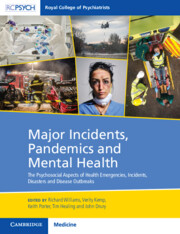 Major Incidents, Pandemics and Mental Health
Major Incidents, Pandemics and Mental Health from Section 1 - The Nature and Impacts of Twenty-First-Century Healthcare Emergencies
Published online by Cambridge University Press: 11 January 2024
Emergencies, incidents, disasters, and disease outbreaks (EIDD) affect children, young people, and their families in many ways, including across generations through epigenetic effects. Their mental wellbeing, life, and routines that continue beyond their injury, illness, or adversity can each be affected. Their reactions and responses can be influenced by the nature and extent of their exposure, personal characteristics, pre-existing vulnerabilities and strengths, and in particular by the family and social support that is offered. Almost all adverse childhood experiences are likely to increase in pandemics and following disasters due to natural and human-induced hazards. Psychosocial problems linked with emergencies are likely to emerge over the year following these events. Social connectedness and social scaffolding mitigate adversity, and promote wellbeing and recovery. This emphasises the importance of a co-ordinated and strategically aligned, psychosocially informed, and evidence-based governmental and system-wide response working across boundaries to support children and families in such crises.
To save this book to your Kindle, first ensure no-reply@cambridge.org is added to your Approved Personal Document E-mail List under your Personal Document Settings on the Manage Your Content and Devices page of your Amazon account. Then enter the ‘name’ part of your Kindle email address below. Find out more about saving to your Kindle.
Note you can select to save to either the @free.kindle.com or @kindle.com variations. ‘@free.kindle.com’ emails are free but can only be saved to your device when it is connected to wi-fi. ‘@kindle.com’ emails can be delivered even when you are not connected to wi-fi, but note that service fees apply.
Find out more about the Kindle Personal Document Service.
To save content items to your account, please confirm that you agree to abide by our usage policies. If this is the first time you use this feature, you will be asked to authorise Cambridge Core to connect with your account. Find out more about saving content to Dropbox.
To save content items to your account, please confirm that you agree to abide by our usage policies. If this is the first time you use this feature, you will be asked to authorise Cambridge Core to connect with your account. Find out more about saving content to Google Drive.